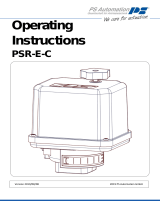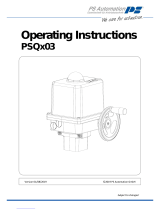
3. Technical data
4
Part-turn actuators SG 03.3 – SG 05.3 with SIMPACT
Part-turn actuators SG 03.3 – SG 04.3 with SIMPACT SE Operation instructions
Application
Part-turn actuator
with integral controls
Electrical operation of valves (e.g. butterfly valves and ball valves)
Features and functions
Type of duty (according to IEC 34-1) Short time duty S2 - 15 min
Motors SIMPACT: Variable speed motor
SIMPACT SE: 3-phase AC motor
Insulation class F, tropicalized
Motor protection Thermoswitches
Self-locking yes
Operating times see technical data sheets SG(R) 03.3 – SG(R) 05.3 AUMA SIMPACT
Swing angle 90° (adjustable from 82° to 98°)
Type of seating by limit switching or torque limiting
Limit switching Counter gear mechanism for end positions OPEN and CLOSED
Standard: Single switch (1 NC and 1 NO) for each end position
Option: Tandem switch (2 NC and 2 NO) for each end position, switches galvanically
isolated
Intermediate positions (option) Electronic intermediate position switches, max. 2 switching points, adjustable
(only in combination with electronic position transmitter RWG 6020)
Torque limiting Electronic current measuring (not available for version SIMPACT SE)
Position feedback signal
(options)
Precision potentiometer
Electronic position transmitter RWG 6020, 0/4 – 20 mA, voltage supply 24 V DC
Mechanical position indicator adjustable indicator disc with symbols OPEN and CLOSED, continuous indication
Running indication (option) in combination with blinker transmitter possible
Heater in switch compartment Standard: Self-regulating heater, 5 – 20 W
110 – 250 V DC/AC or 24 – 48 V DC/AC
Manual operation Manual drive for setting and emergency operation, handwheel does not rotate during
electric operation
Handwheel lockable (option) yes
Local controls Selector switch LOCAL–OFF–REMOTE, lockable
Local control switch OPEN – STOP – CLOSE
3 indication lights:
End position OPEN (green)
motor protection tripped (red)
end position CLOSED (yellow)
Electrical connection
Electrical connection Standard: AUMA plug/socket connector with screw type connection
Option: Double sealed (double sealed plug/socket connector)
Threads for cable glands Standard: 1 x M20x1.5, 2 x M25x1.5
Options: Pg-threads
NPT threads
Terminal plans SIMPACT: KMS G141011C0D1000 (basic version with local controls)
SIMPACT SE: KMS B101011ASE1000 (basic version with 3-phase AC motor)
Interfaces
Inputs (input signals) SIMPACT: REMOTE OPEN, REMOTE CLOSE; galvanic isolation via opto-isolators
Standard: 24 V DC, current consumption: approx. 8 mA per input
Options: 110 – 120 V AC, current consumption: approx. 6.6 mA per input
220 – 240 V AC, current consumption: approx. 3.6 mA per input
SIMPACT SE: REMOTE OPEN, REMOTE CLOSE
Standard: 110 – 120 V AC or 220 – 240 V AC
Outputs SIMPACT: Ready for operation – Fault (Motor protection, torque limiting tripped)
Further signals: End positions OPEN - CLOSED/selector switch
LOCAL - REMOTE
Rating of the signal relays: max. 250 V AC, 2 A (resistive load)
SIMPACT SE: Ready for operation – Fault (Motor protection)
Further signals: End positions OPEN - CLOSED/selector switch
LOCAL - REMOTE
Valve attachment
Valve attachment Dimensions according to EN ISO 5211
Coupling splined coupling for connection to the valve shaft, part-turn actuator
can be repositioned 4 x 90° on coupling
Standard: Coupling without bore
Options: Machined coupling with bore and keyway, square bore or bore with two-flats
Table 1: Technical data part-turn actuator SG 03.3 – SG 05.3





















